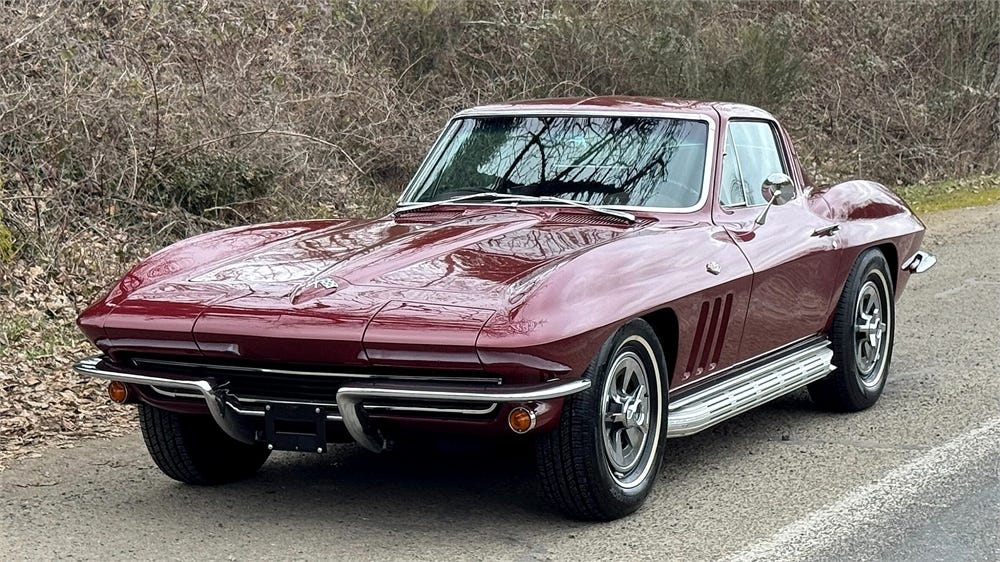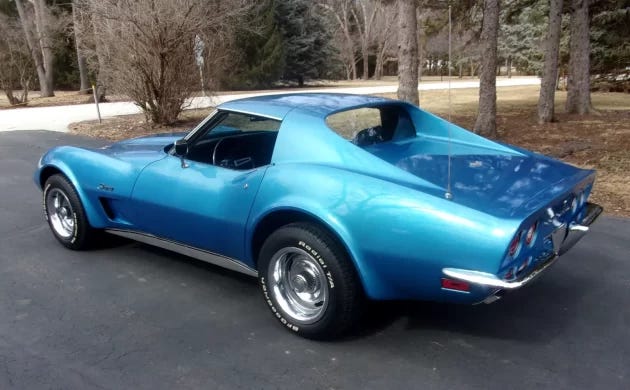Value/Price Disparity: C2 vs. C3
A story of two Corvette generations
1965 Milano Maroon coupe, 327ci/300hp engine, 4-speed manual transmission
1973 Medium Blue coupe, 350ci/250hp engine, 4-speed manual transmission
How do you account for the chasm in selling prices between the C2 and early C3 generations? The period between the mid-1960s and early 1970s is a short amount of time. Let’s see if comparing the two examples above provides any insights.
The ‘65 coupe pictured above is a good example of the C2 generation. My brother had been watching the auction for this car and sent me an email to bring it to my attention. It is a gorgeous-looking car. I love the C2 as much as anybody - I had owned three of them in a row a long time ago.
In fact, my first Corvette was a ‘65 Milano Maroon roadster with a 327ci/350hp engine and four-speed transmission. To this day, I’m still enthralled by the iconic exterior and interior designs of the “mid-year” cars. I especially love the above ‘65 with the maroon interior and side exhaust (I never owned a Corvette with that exhaust).
This car was bid up to $67,000 in an online auction, but the reserve wasn’t met and it didn’t sell. It went to the “The Bidding Continues…” section of the site and it still hasn’t sold three days after the auction ended. In the current Corvette market, the seller is probably looking to sell it in the mid to high $70k range.
The ‘73 coupe pictured above is a good example of the early C3 generation. I really like this car as well - it has only 38,000 miles that are fully documented by the seller with receipts and vehicle history. The seller has owned this car for forty years, having bought it from the original owner who owned it for less than a year and put under 1,000 miles on it. It’s completely original, I love the color, and the interior shows almost no wear.
I owned two early C3s back in the day: a blue ‘68 coupe with a 327ci/350hp engine and 4-speed, and a ‘70 convertible with a 350ci/350hp engine and 4-speed. The ‘68 was the worst Corvette I ever owned (I won’t go into all the issues), but the ‘70 was perfect in every way. It still boggles my mind to this day how two years could make such a difference.
The ‘73 above was for sale on eBay for $29,000 or best offer. It sold quickly for probably a price in the high 20s, which I think is in line with the current selling prices for these cars.
In comparing these two specific cars, the ‘65 is an absolutely beautiful car in great condition, but the ‘73 is also really nice and I love pretty much everything about it. However, it seems like there is a huge disparity in the perceived value and asking prices between these cars, considering that the chassis and running gear of both of these cars are nearly the same.
Do you think the ‘65 is worth almost three times as much as the ‘73?
It seems like the C2 market has evolved into a big-money sport in which well-heeled participants bid up the prices of these cars. Yes, I understand that the iconic design of the second-generation and the short production run make these cars especially collectible. But after paying almost six figures, many owners don’t even drive these C2s very much.
The early chrome-bumper C3s have risen in price over the last several years, but don’t seem destined to ever become as wildly popular as the previous generation. There’s a lot to like about these cars, and at the price of entry, many owners are more comfortable driving and enjoying them.
Prices are usually determined by market forces such as supply and demand, which may partially explain the price discrepancy. The five-year C2 production probably resulted in fewer cars being built than the total number of C3s built between 1968 and 1973. So the price disparity between the C2s and early C3s will probably not change anytime soon.
For more of my posts, go to https://corvetteblog.substack.com/

